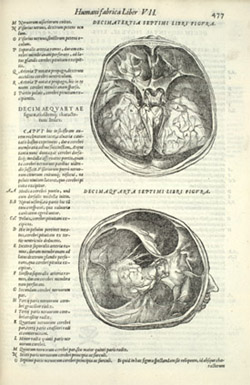|
|
|
|
|
|
|
|
|
|
|
|
|
|
|
|
|
|
| VESALIUS, Andreas
|
| De Humani Corporis Fabrica
|
| Venice: Franceschi & Criegher, 1568
|
| Folio, 215 x 315 mm. (6) ff, 510 pp., (23) ff.
|
| Early limp vellum, gauffered edges.
|
|
|
|
|
|
|
|
|
|
|
|
|
|
|
|
|
|
|
|
|
|
|
|
|
|
The appearance of Vesalius' De humani corporis fabrica in 1543 was a pivotal moment in the science of anatomy. The book rightly remains esteemed as the first and most important modern anatomical treatise. Although many anatomical manuscripts and books pre-date 1543, they are characterized by a clumsy, schematic portrayal of the human body that was largely speculative, owing to the Catholic Church's opposition to autopsy and dissection of the human body (see Albini/Eustachi). The plates by Vesalius display a stunning realism and detail, drawn from life using cadavers that were often covertly obtained and dissected.
|
|
|
|
The first edition appeared as a large folio of monumental format, which was reproduced in the second edition of 1555. In 1568 a third edition was printed in Venice in a smaller format more suited to actual use in the operating theater and anatomical laboratory. The plates were re-cut in reduced size and without the decorative backgrounds present in the earlier editions, in keeping with the book's more practical purpose.
|

